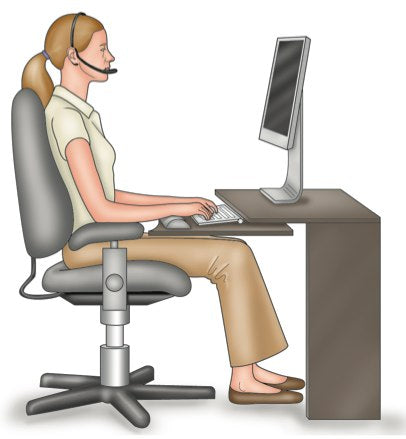Taking The Perfect Case History - What Really Matters?
Learning to Listen To Your Client - Dr. Jonathan Kuttner M.D.
Communication with your client can often be the key factor in helping them engage with their treatment and recovery
When conducting trigger point therapy, it is generally advisable to encourage the client to get involved in managing their own symptoms.
Where appropriate, and if it is within your scope of practice, you might want to include hints, tips, and advice using some of the following elements or components.
Strengthening
Muscles are more susceptible to damage, fatigue, and injury when they are weak. Weakness is often a contributory factor in the pathogenesis of myofascial trigger points.
This is because the body overcompensates for the weakness and strains in the muscle, overloading and overstimulating the motor endplate.
One muscle should never be strengthened in isolation.
If you do offer strengthening exercises, it is advisable to put them in context and where possible. It is always important for the client to understand the connection between the exercises and the treatment process.
Stretching
We find that clients who stick to a stretching program between therapy sessions, almost always respond faster and better to treatment.
Whilst the evidence supporting this is confusing and often contradictory, it is generally accepted by trigger point therapists that stretching between sessions helps.
Stretching should be performed slowly, and without bouncing. Care must be taken to isolate the stretch to the specific muscle as far as possible.
As a rule, stretches should be performed three times, slightly deepening the stretch with an out-breath each time.
This sequence should be performed several times per day, for approximately 15–20 minutes.
Common Sense
Chatting with the client about their injury and their lifestyle habits can often help us explore and eliminate any chemical or nutritional deficit.
We will also often help patients to analyze different lifestyle situations in the context of their injury, for instance, “Look at your driving position” or “Look at your everyday work set-up.”
When treating trigger points in the pectoralis major muscle for example, you may ask the patient about their stress or anxiety levels (rib breathing mechanics).
If the patient has large, heavy breasts, you may want to advise on a more appropriate bra or support.
Helping clients to understand their injury in the context of their lifestyle can both help accelerate recovery and prevent a re-occurrence.
Posture
Posture may well have a crucial role in maintaining trigger point activity. Faulty sitting and/or standing postures are both a pathogenic and a maintaining factor for trigger point activity.
Advice and exercises for posture is often the key to unlocking both central and satellite points.
Sleeping Posture
We almost always discuss sleeping posture with each client.
Clients frequently assume strange postures at night. This will sometimes be done to reduce the pain from either active or stiff latent trigger points.
In such cases, patients often opt for a sleeping position that shortens the affected muscle: for example, they sleep with either the hands above the head (supraspinatus), or the arms folded over the chest (pectoralis major).
In other cases, it may be that the sleeping position is a pathogenic or a maintaining factor.

Ideal Work Posture - very few pay enough attention to this!
Work Posture
Some clients may have manual or repetitive activities in the workplace and these may well have a role to play in trigger point pathogenesis or maintenance.
More and more of our clients spend their time working with tech devices (tablets, phones, laptops) and we will almost always have a chat to these clients about posture at work.
Habitual Activity, Hobbies, and Sports
Similarly, it is important to ask the client if they perform any repetitive or habitual activities apart from at work. Standing for long periods of the day on one leg, for example, may well overload the TFL muscle.
Sitting in a cross-legged position may affect a range of muscles, such as the hip flexors (iliopsoas), the buttock muscles (gluteals and piriformis), and the thigh muscles (quadriceps).
We know from studies that heavy smokers may develop trigger points in the shoulder (deltoid) and arm (biceps brachii) muscles.
Certain hobbies and sports may also lead to an increased incidence of trigger point pathogenesis.
It is important to enquire carefully about such activities. What is the clients level of competence? Do they warm up, and cool down? How competitive are they? Is their level of activity realistic for their age? Posture? Body type? Physical health? You may want to explore these areas further.
In summary, communication with your client can often be the key factor in helping them engage with their treatment and recovery.
Links
Find a Trigger Point Professional in your area
More Articles About Trigger Points
More Articles About Piriformis
Certify as a Trigger Point Therapist
About NAT Courses
As a manual therapist or exercise professional, there is only one way to expand your business - education!
Learning more skills increases the services that you offer and provides more opportunity for specialization.
Every NAT course is designed to build on what you already know, to empower you to treat more clients and grow your practice, with a minimal investment in time and money.
Help Desk
About Niel Asher Education
Niel Asher Education is a leading provider of distance learning and continued education courses.
Established in the United Kingdom in 1999, we provide course and distance learning material for therapists and other healthcare professionals in over 40 countries.
Our courses are accredited by over 90 professional associations and national accreditation institutions including the National Academy of Sports Medicine (NASM) and National Certification Board for Therapeutic Massage and Bodywork (NCBTMB). Full details of all international course accreditations can be found on our website.
Printed course materials and other products offered on our websites are despatched worldwide from our 3 locations in the UK (London), USA (Pennsylvania) and Australia (Melbourne).
More About Us
NAMTPT AWARD 2017
We are honored to have received the 2017 "Excellence in Education" Award from the National Association of Myofascial Trigger Point Therapists.
Since 1999 Niel Asher Education has won numerous awards for education and in particular for education and services provided in the field of trigger point therapy.
Read Full Article
Award Winning Instructors
Niel Asher Healthcare course instructors have won a host of prestigious awards including 2 lifetime achievement honorees - Stuart Hinds, Lifetime Achievement Honoree, AAMT, 2015, and Dr. Jonathan Kuttner, MD, Lifetime Achievement Honoree, NAMTPT, 2014.
Meet the Instructors
Accreditation

If you are a qualified/licensed manual therapist or exercise/fitness professional you can expand your credentials with NAT certification.
In addition to national accreditation for continued education, each course that we offer includes "NAT Learning Credits". By taking and completing courses you can accumulate NAT credits to qualify for NAT certification.
There are currently 3 levels of NAT certification. Certifying NAT is a valuable way to show your clients that you take continued education seriously, and to promote your skills and qualifications.
Most of our courses are accredited for CE/CPD/CPE. A full list of CE accreditations can be found by clicking on the link below.
About NAT Certification
Niel Asher Technique
Since 1999 the Niel Asher Technique for treating trigger points has been adopted by over 100,000 therapists worldwide, and has been applied to the treatment of a number of common musculoskeletal injuries.
The Niel Asher Technique for treating frozen shoulder was first introduced and published in 1997 and has been widely adopted by therapists and exercise professionals working within elite sports and athletics.
Read More
International Students
Most of our courses are available as either "Printed" or 'Download" editions, wherever you live. Internet connection is required to access online and downloadable material.
When you purchase a download edition, you receive immediate lifetime access to all course material. Course texts can be downloaded and printed if required.
When you purchase a "Printed" edition, you will also receive free access to the download edition.
We ship Worldwide from locations in the USA, UK, and Australia. Most items are despatched within 24 hours and shipping is FREE for all orders over US$50.
Shipping
Where to Start?
We offer a range of over 50 courses, presented by some of the worlds leading manual therapists. All courses are reviewed annually, and new courses are regularly added.
Our courses are modular, and designed to build on what you already know. For more information, please visit our "Where to Start?" page.
Start Here
Trigger Point Therapy Master Course

Continuing Professional Education
Looking for Massage Therapy CEUs, PT and ATC continuing education, chiropractic CE, or advanced manual therapy training? Explore our evidence-based online courses designed for hands-on professionals.



















